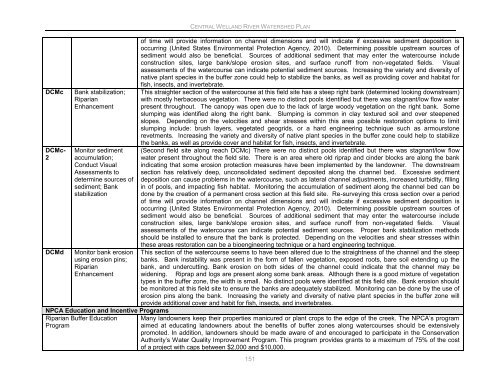Central Welland River Watershed Plan - Niagara Peninsula ...
Central Welland River Watershed Plan - Niagara Peninsula ...
Central Welland River Watershed Plan - Niagara Peninsula ...
- No tags were found...
You also want an ePaper? Increase the reach of your titles
YUMPU automatically turns print PDFs into web optimized ePapers that Google loves.
CENTRAL WELLAND RIVER WATERSHED PLANof time will provide information on channel dimensions and will indicate if excessive sediment deposition isoccurring (United States Environmental Protection Agency, 2010). Determining possible upstream sources ofsediment would also be beneficial. Sources of additional sediment that may enter the watercourse includeconstruction sites, large bank/slope erosion sites, and surface runoff from non-vegetated fields. Visualassessments of the watercourse can indicate potential sediment sources. Increasing the variety and diversity ofnative plant species in the buffer zone could help to stabilize the banks, as well as providing cover and habitat forfish, insects, and invertebrate.DCMc Bank stabilization;RiparianEnhancementThis straighter section of the watercourse at this field site has a steep right bank (determined looking downstream)with mostly herbaceous vegetation. There were no distinct pools identified but there was stagnant/low flow waterpresent throughout. The canopy was open due to the lack of large woody vegetation on the right bank. Someslumping was identified along the right bank. Slumping is common in clay textured soil and over steepenedslopes. Depending on the velocities and shear stresses within this area possible restoration options to limitslumping include: brush layers, vegetated geogrids, or a hard engineering technique such as armourstonerevetments. Increasing the variety and diversity of native plant species in the buffer zone could help to stabilizethe banks, as well as provide cover and habitat for fish, insects, and invertebrate.DCMc-2Monitor sedimentaccumulation;Conduct VisualAssessments todetermine sources ofsediment; Bankstabilization(Second field site along reach DCMc) There were no distinct pools identified but there was stagnant/low flowwater present throughout the field site. There is an area where old riprap and cinder blocks are along the bankindicating that some erosion protection measures have been implemented by the landowner. The downstreamsection has relatively deep, unconsolidated sediment deposited along the channel bed. Excessive sedimentdeposition can cause problems in the watercourse, such as lateral channel adjustments, increased turbidity, fillingin of pools, and impacting fish habitat. Monitoring the accumulation of sediment along the channel bed can bedone by the creation of a permanent cross section at this field site. Re-surveying this cross section over a periodof time will provide information on channel dimensions and will indicate if excessive sediment deposition isoccurring (United States Environmental Protection Agency, 2010). Determining possible upstream sources ofsediment would also be beneficial. Sources of additional sediment that may enter the watercourse includeconstruction sites, large bank/slope erosion sites, and surface runoff from non-vegetated fields. Visualassessments of the watercourse can indicate potential sediment sources. Proper bank stabilization methodsshould be installed to ensure that the bank is protected. Depending on the velocities and shear stresses withinthese areas restoration can be a bioengineering technique or a hard engineering technique.DCMd Monitor bank erosionusing erosion pins;RiparianThis section of the watercourse seems to have been altered due to the straightness of the channel and the steepbanks. Bank instability was present in the form of fallen vegetation, exposed roots, bare soil extending up thebank, and undercutting. Bank erosion on both sides of the channel could indicate that the channel may beEnhancement widening. Riprap and logs are present along some bank areas. Although there is a good mixture of vegetationtypes in the buffer zone, the width is small. No distinct pools were identified at this field site. Bank erosion shouldbe monitored at this field site to ensure the banks are adequately stabilized. Monitoring can be done by the use oferosion pins along the bank. Increasing the variety and diversity of native plant species in the buffer zone willprovide additional cover and habit for fish, insects, and invertebrates.NPCA Education and Incentive ProgramsRiparian Buffer EducationProgramMany landowners keep their properties manicured or plant crops to the edge of the creek. The NPCA‟s programaimed at educating landowners about the benefits of buffer zones along watercourses should be extensivelypromoted. In addition, landowners should be made aware of and encouraged to participate in the ConservationAuthority‟s Water Quality Improvement Program. This program provides grants to a maximum of 75% of the costof a project with caps between $2,000 and $10,000.151
















